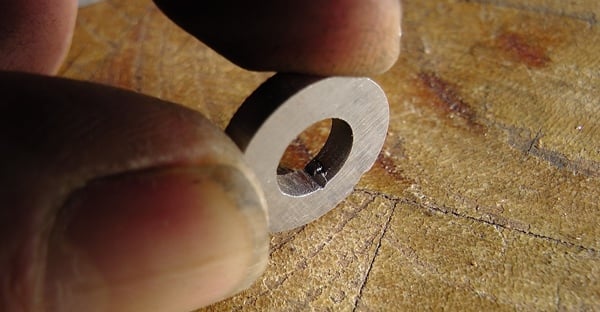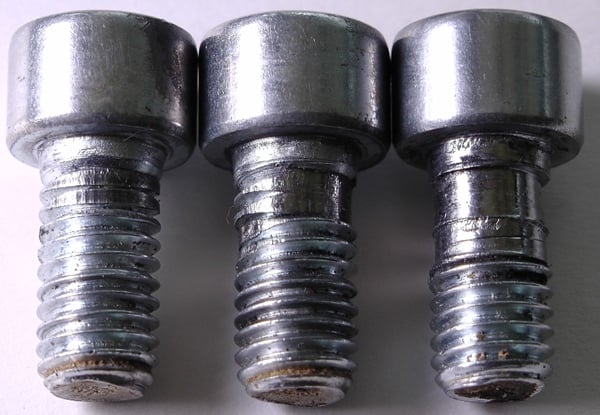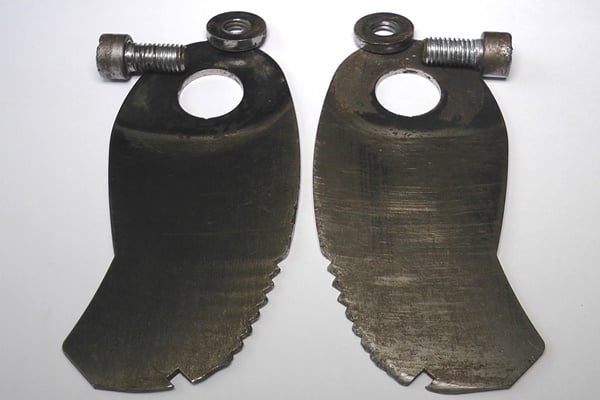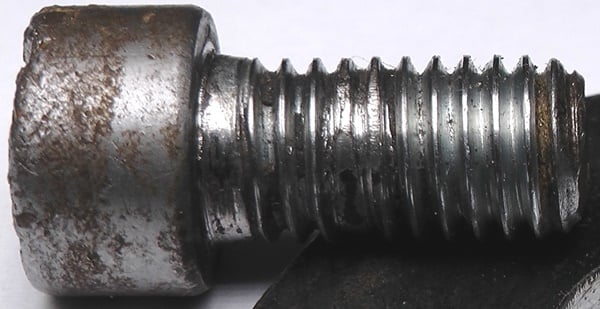There is a potential risk that new harder bush washers can wear through pivot bolts resulting in failure and the release of a Flail-Blade while in use, which must never happen. Below is a photo sent in by a commercial customer, showing significant wear to his high tensile pivot bolts.
Cause –
In that particular case the fault was mine, in that I forgot to torque up the nuts on three blades that got sent out in a rush to meet the mail pick up. In a way this was fortunate at it brought to light a potential serious problem and that is that if a customer also at some stage forgets to torque up the nuts when replacing blades the bush washer can pivot on the bolt causing unacceptable wear.
This was not a problem I came across when spending many hours testing the new model blades as I always checked to see if the nut and bolt showed any signs of coming loose which they did not. Since receiving the photo above, I checked a handful of the bush washers (about 100) to see if the laser serration were acting as a file to cause this much wear and what I did find was that a number bush washers had blobs of molten metal at the laser start stop point. These bushes are as hard as a file, so you can see the damage that could be caused if the bush washer was allowed to rotate on the bolt.
I then did a number of hours testing the new blade with one bolt done up very tight, one just nipped up tight and one lose so that the nut and bolt could be easily rotated with my fingers. Below is the state of the three bolts after three tanks of fuel (about 4 hours) of hard clearing. The bolt on the right had a bush that has had the inner hole reamed out smooth, to see if a loose smooth washer would cause much damage.
The left bolt, you can see how the laser marks of the bush washer had imprinter itself into the bolt under the high loads, but had not rotated.
The middle bolt, you can see that the bush washer was rotating on the bolt and wearing the bolt.
The right bolt, you can see that the bush washer was rotating on the bolt and the bolt was also rotating in the top and bottom hub holes.
What did surprise me was the amount of wear on the middle bolt, as I had assumed the ground smooth outside face of the bush washer and the pivot hole in the flail-blade would be produce less friction than the rough finish of the inner bush washer hole plus the total surface area of the top and bottom face of the bush washer compressed between the hub faces. I then started researching this and was again surprised to find that friction is not proportional to diameter size. To try and explain this simply, you would think that the resistance to rotate caused by friction would be the same between two different shaft diameters with the same load. Imagine a train wagon where the front wheel has an axle twice the diameter of the rear wheel and the load on each axle is the same. The front axle would have a bearing surface area twice that of the rear axle but the load on that bearing surface would be half that of the rear axle. You would think that the friction on each wheel would be the same, but it is not proportional. So the resistance to rotating is much, much higher on a larger diameter than a smaller diameter, which is why the bush wants to always rotate on the bolt instead of the blade rotating on the bush. Sorry for the physic lesson, hope I didn’t lose you.
I am surmising here, that I think some heat is generated in the bush when the blade is flicking back and forth a lot and this allow the bolt to expand a little bit, which reduces the pressure between the bush and hub faces which reduces the friction and allows the bush washer to rotate when the bolt is hot.
Now if I can forget to torque the nuts up tight, than a customer could easily do the same and to let this sort of wear go unchecked is unacceptable and could eventually result in a flail-blade flying loose which must never happen.
Solution –
Prevent the washer from rotating on the bolt, even if the nut is not done up tight. This I plan to achieve but threading the inside hole of the bush washer, so that when it is sandwiched in between the top and bottom hubs, it cannot rotate without trying to screw up or down the bolt thread which the rough faces and hubs will prevent from happening.
This process considerably adds to the cost of the bush and will make it more difficult to quickly replace the Flail-Blades in the field. As you will now need to put the blade in a vice or use vice grips to prevent the threaded washer from rotating while you undo the bolt, especially after the thread has sustained some crush damage after long use.
But I think you will agree it is a very worthwhile expense and inconvenience.
Below are some photos of threaded bush washer and bolt after eight hours of hard use.
Close up of bolt and bush washer
As you can see there is almost no wear between the blade pivot hole and bush-washer and not damage to the bolt from the bush washer. You can see a small amount of damage, where the bolt thread has been crushed against the hole in the top hub.
This will make it harder to undo the bolt from the bush washer and this is where you will need vice-grips to prevent the bush washer from rotating.
Like this page, please share it with a friend










